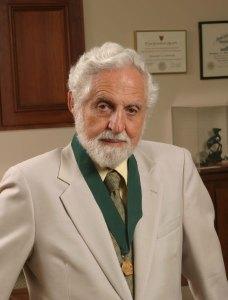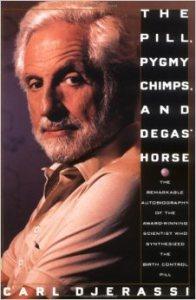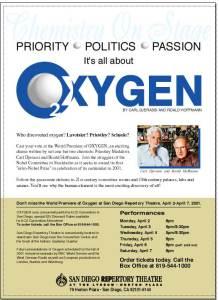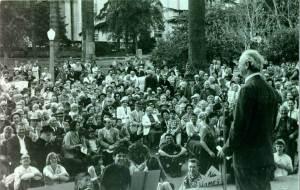
Carl Djerassi, who passed away on January 30, 2015 due to complications of liver and bone cancer, was a remarkable scientist, a talented author, and a friend of Linus Pauling. The Austrian-born Bulgarian Jew was known as the father of the birth control pill and also developed antihistamines. But the intersection of his knowledge of science and his talent for writing was perhaps the most fruitful element of his life. His literature focused on the practice and production of science, but also served to bring the unique issues and concerns of the scientific community to a larger audience and to educate them on the basics of the science.
In addition to his formal scientific work, Djerassi was also a novelist and playwright, and he found the need to educate to be the most important aspect of his work in fiction. Doing so in an effective manner naturally required skill and precise navigation so the reader or playgoer was not confused or bored. In order to keep his audience entertained and focused, Djerassi believed it to be of utmost importance to maintain a story throughout the work; only then could he incorporate real science and realistic scientists as his characters.

Djerassi’s approach was similar to that taken by Linus Pauling, who also placed great importance on the need for the general public to be educated about big issues in science. Indeed, the two men were colleagues for a time when Pauling was at Stanford University from 1969-1972, and they remained in contact outside of this affiliation.
In fact, Djerassi wrote to Pauling asking him to provide back matter for his autobiography, The Pill, Pygmy Chimps, and Degas’ Horse: the Remarkable Autobiography of the Award-winning Scientist Who Synthesized the Birth Control Pill, because he could think of no other chemist who was so well-known to the public.
Pauling was glad to serve in this capacity, noting in a letter that he “found the first few pages of [the] autobiography so interesting that for two days I neglected my work in order to read the book from beginning to end.” Although Pauling enjoyed the book’s discussion of Djerassi’s work on The Pill, “even more interesting [were] the chapters on his adventure-filled life, the Pugwash movement, and other aspects of world affairs, the problem of continually increasing population, and other aspects of the world of today.”
At various point throughout his book, Djerassi likewise aligned himself with an ideology similar to Pauling’s. In the introduction, Djerassi wrote that
scientists are not necessarily narrow specialists, communicating in an incomprehensible language and dealing in the cloistered ambiance of their laboratories with subjects far removed from everyday concerns…they can be as widely curious, and as self-centeredly imperfect, as scholars and thinkers in any intellectual endeavor and, at the same time, involve themselves with burning social issues.
This emphasis on the need for scientists to participate in social issues beyond their professional interests is central to understanding what both Djerassi and Pauling chose to write about and how they presented their ideas to the public.

Flyer for “Oxygen,” a play written by Carl Djerassi and Roald Hoffmann.
One key difference, of course, is that Djerassi often promoted his ideas in works of fiction that strove to educate his audience in such a way that, by the time they had finished the play or novel, they could explain the scientific process around which the work was centered. He described this genre of writing as “science-in-fiction,” which was not meant to be confused with science fiction but instead hinged on the premise that if it were not for the science in the work, the work itself could not exist. Djerassi further noted that, by presenting the material in this manner and disguising science as fiction, “science-in-fiction allows the illustration and discussion of ethical dilemmas that are frequently not raised for reasons of discretion, embarrassment, or fear of retribution.”
Starting in the 1980s, when he first began writing science-in-fiction, Djerassi also devoted time to writing “science-in-theater,” the production of science-in-fiction as presented on stage. One product of this genre was An Immaculate Conception: Sex in the Age of Mechanical Reproduction (2000), which Djerassi used as a platform to discuss intra-cytoplasmic sperm injection (ICSI) and its impact on personal views concerning human reproduction. Because the discussion was couched in the form of a play, it was naturally conducted in a public setting and thus carried forth without – to paraphrase Djerassi – need for discretion or fear of embarrassment or retribution.

Linus Pauling speaking at a peace march in Westlake Park. Beverly Hills, California. 1960. Photo by Robert Carl Cohen.
Despite their strongly shared principle belief in the importance of educating the public, Pauling’s work was quite different from that of Djerassi. Although he too tried to bring science to life, Pauling never turned to fiction to deliver his points. Instead he tried to present the science as it was, but in terms that an audience member or reader could understand. This focus on the lay audience was central to his speech writing and carried over into his published work as well.
Pauling was extremely rational in his thinking and he sought to use his scientific background not just to describe the science at hand, but also to educate others so that they could draw their own conclusions concerning scientific discoveries and current events. But there are numerous examples where he took another step. For Pauling, issues of nuclear testing, radioactive fallout, and nuclear disarmament were central to his most well-known rhetoric of the late 1950s. While often methodical in his presentations, Pauling’s discussions of fallout regularly used charged language that played on the feelings and fears of his audience, in the process drawing from the emotional tension of the Cold War and the audience’s concerns over what another war would entail.
Pauling also tried to dispel the notion held by much of the public that there was disagreement among scientists as to the actual effects of radiation on humans. His book, No More War!, served as a vehicle for him to promote his own ideas and concerns for a future world and to outline remedies for how these problems might be alleviated. In this, he went one step further than merely educating the reader or audience member as Djerassi had done. Education was important, but Pauling also fought for the attention of politicians who could enact the policies that scientists could not.
